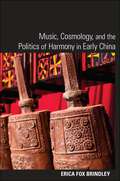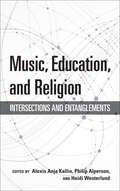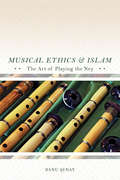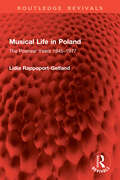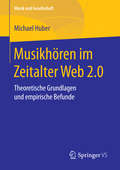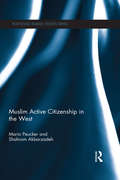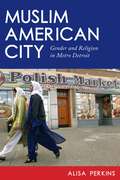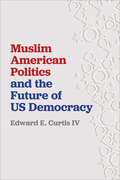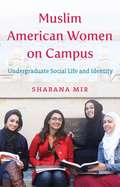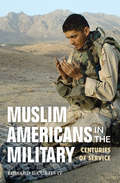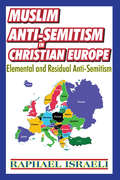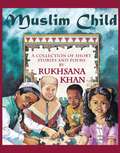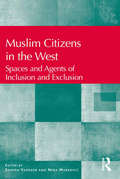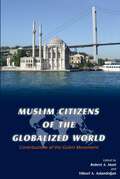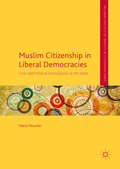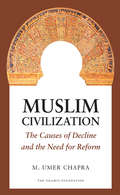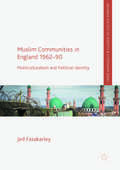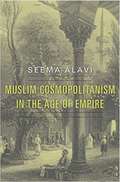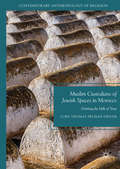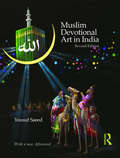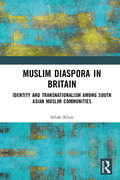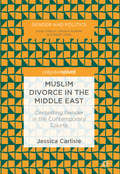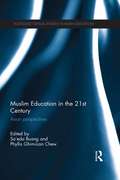- Table View
- List View
Music, Cosmology, and the Politics of Harmony in Early China (SUNY series in Chinese Philosophy and Culture)
by Erica Fox BrindleyWinner of the 2013 Reading Committee Accolade for a Specialist Publication in the Humanities presented by the International Convention of Asia ScholarsIn early China, conceptions of music became important culturally and politically. This fascinating book examines a wide range of texts and discourse on music during this period (ca. 500–100 BCE) in light of the rise of religious, protoscientific beliefs on the intrinsic harmony of the cosmos. By tracking how music began to take on cosmic and religious significance, Erica Fox Brindley shows how music was used as a tool for such enterprises as state unification and cultural imperialism. She also outlines how musical discourse accompanied the growth of an explicit psychology of the emotions, served as a fundamental medium for spiritual attunement with the cosmos, and was thought to have utility and potency in medicine. While discussions of music in state ritual or as an aesthetic and cultural practice abound, this book is unique in linking music to religious belief and demonstrating its convergences with key religious, political, and intellectual transformations in early China.
Music, Education, and Religion: Intersections and Entanglements (Counterpoints: Music and Education)
by Edited by Alexis Anja Kallio, Philip Alperson, and Heidi WesterlundEssays examining the role of religion in music education from a variety of perspectives.Music, Education, and Religion: Intersections and Entanglements explores the critical role that religion can play in formal and informal music education. As in broader educational studies, research in music education has tended to sidestep the religious dimensions of teaching and learning, often reflecting common assumptions of secularity in contemporary schooling in many parts of the world. This book considers the ways in which the forces of religion and belief construct and complicate the values and practices of music education—including teacher education, curriculum texts, and teaching repertoires. The contributors to this volume embrace a range of perspectives from a variety of disciplines, examining religious, agnostic, skeptical, and atheistic points of view. Music, Education, and Religion is a valuable resource for all music teachers and scholars in related fields, interrogating the sociocultural and epistemological underpinnings of music repertoires and global educational practices.&“The book serves as a study volume for all those who are active in this field and provides both systematic reflections and useful empirical studies. A further impressive feature is the regional and religious breadth of the content presented and examined.&” —Wolfgang W. Müller, Reading Religion
Musical Ethics and Islam: The Art of Playing the Ney
by Banu SenayAfter the establishment of the Turkish Republic, Turkey's secularized society disdained the ney, the Sufi reed flute long associated with Islam. The instrument's remarkable revival in today's cities has inspired the creation of teaching and learning sites that range from private ney studios to cultural and religious associations and from university clubs to mosque organizations. Banu Şenay documents the years-long training required to become a neyzen—a player of the ney. The process holds a transformative power that invites students to create a new way of living that involves alternative relationships with the self and others, changing perceptions of the city, and a dedication to craftsmanship. Şenay visits reed harvesters and travels from studios to workshops to explore the practical processes of teaching and learning. She also becomes an apprentice ney-player herself, exploring the desire for spirituality that encourages apprentices and masters alike to pursue ney music and its scaffolding of Islamic ethics and belief.
Musical Life in Poland: The Postwar Years 1945–1977 (Routledge Revivals)
by Lidia Rappoport-GelfandNever in the history of Polish music has there been a period like the one that followed World War II. No other era has given the world so many outstanding composers and so many talented works in all kinds of musical genres. Polish music asserted itself on the world scene as independent, distinct, and creatively important phenomenon.First published in English in 1991, Musical Life in Poland outlines the general trends of the evolution of postwar music in Poland by periods. The author discusses in detail the specifics of national traditions of Polish culture and art, beginning with the purely Polish romantic and expressive tradition and ending with the powerful influence of Catholicism on art. She introduces a large group of talented composers and their artistically valuable works to the English-speaking reader and comprehensively covers musical culture in Poland.
Musikhören im Zeitalter Web 2.0
by Michael HuberIn Anschluss an aktuelle Erkenntnisse soziologischer und sozialpsychologischer Musikrezeptionsforschung erläutert der Band, welche gesellschaftlichen Funktionen das Musikhören heute erfüllt und welche Rolle hier die neuen Rahmenbedingungen im Web 2.0 spielen. Auf Basis repräsentativer empirischer Erhebungen werden musikalische Einstellungen und Verhaltensweisen illustriert sowie klar abgrenzbare Musikhörtypen charakterisiert, die in je besonderer Weise mit den aktuellen Möglichkeiten und Herausforderungen der digitalen Mediamorphose umgehen. Besondere Berücksichtigung findet dabei die Frage nach der Bedeutung primärer Sozialisation als Gegengewicht zur musikalischen Selbstsozialisation im Internet. Vor allem Alter, Schulbildung und Wohnortsgröße der Menschen zeigen sich als entscheidende Einflussgrößen der individuellen musikalischen Praxis in Österreich.
Muslim Active Citizenship in the West (Routledge Islamic Studies Series)
by Mario Peucker Shahram AkbarzadehMuslim Active Citizenship in the West investigates the emergence and nature of Muslims’ struggle for recognition as full members of society in Australia, Great Britain and Germany. What actions have been taken by Muslims to achieve equal civic standing? How do socio-political and socio-economic factors impact on these processes? And how do Muslims negotiate their place in a society that is often regarded as sceptical – if not hostile – towards Muslims’ desire to belong? This book sheds new light on Muslims’ path towards citizenship in Australia, Great Britain and Germany. Existing research and statistics on Muslims’ socio-economic status, community formation, claim-making and political responses, and the public portrayal of Islam are systematically examined. These insights are tested ‘through the eyes of Muslims’, based on in-depth interviews with Muslim community leaders and other experts in all three countries. The findings offer unique perspectives on Muslim resilience to be recognised as equal citizens of Islamic faith in very different socio-political national settings. Pursuing an interdisciplinary and comparative approach, this book examines the country-specific interplay of historical, institutional, political, and identity dimensions of Muslims’ active citizenship and will be invaluable for students and researchers with an interest in Sociology, Religious Studies and Political Science.
Muslim American City: Gender and Religion in Metro Detroit
by Dr. Alisa PerkinsExplores how Muslim Americans test the boundaries of American pluralismIn 2004, the al-Islah Islamic Center in Hamtramck, Michigan, set off a contentious controversy when it requested permission to use loudspeakers to broadcast the adhān, or Islamic call to prayer. The issue gained international notoriety when media outlets from around the world flocked to the city to report on what had become a civil battle between religious tolerance and Islamophobic sentiment. The Hamtramck council voted unanimously to allow mosques to broadcast the adhān, making it one of the few US cities to officially permit it through specific legislation.Muslim American City explores how debates over Muslim Americans’ use of both public and political space have challenged and ultimately reshaped the boundaries of urban belonging. Drawing on more than ten years of ethnographic research in Hamtramck, which boasts one of the largest concentrations of Muslim residents of any American city, Alisa Perkins shows how the Muslim American population has grown and asserted itself in public life. She explores, for example, the efforts of Muslim American women to maintain gender norms in neighborhoods, mosques, and schools, as well as Muslim Americans’ efforts to organize public responses to municipal initiatives. Her in-depth fieldwork incorporates the perspectives of both Muslims and non-Muslims, including Polish Catholics, African American Protestants, and other city residents. Drawing particular attention to Muslim American expressions of religious and cultural identity in civil life—particularly in response to discrimination and stereotyping—Perkins questions the popular assumption that the religiosity of Muslim minorities hinders their capacity for full citizenship in secular societies. She shows how Muslims and non-Muslims have, through their negotiations over the issues over the use of space, together invested Muslim practice with new forms of social capital and challenged nationalist and secularist notions of belonging.
Muslim American Politics and the Future of US Democracy
by Edward E Curtis IVReveals the important role of Muslim Americans in American politics Since the 1950s, and especially in the post-9/11 era, Muslim Americans have played outsized roles in US politics, sometimes as political dissidents and sometimes as political insiders. However, more than at any other moment in history, Muslim Americans now stand at the symbolic center of US politics and public life. This volume argues that the future of American democracy depends on whether Muslim Americans are able to exercise their political rights as citizens and whether they can find acceptance as social equals. Many believe that, over time, Muslim Americans will be accepted just as other religious minorities have been. Yet Curtis contends that this belief overlooks the real barrier to their full citizenship, which is political rather than cultural. The dominant form of American liberalism has prevented the political assimilation of American Muslims, even while leaders from Eisenhower to Obama have offered rhetorical support for their acceptance. Drawing on examples ranging from the political rhetoric of the Nation of Islam in the 1950s and 1960s to the symbolic use of fallen Muslim American service members in the 2016 election cycle, Curtis shows that the efforts of Muslim Americans to be regarded as full Americans have been going on for decades, yet never with full success. Curtis argues that policies, laws, and political rhetoric concerning Muslim Americans are quintessential American political questions. Debates about freedom of speech and religion, equal justice under law, and the war on terrorism have placed Muslim Americans at the center of public discourse. How Americans decide to view and make policy regarding Muslim Americans will play a large role in what kind of country the United States will become, and whether it will be a country that chooses freedom over fear and justice over prejudice.
Muslim American Women on Campus
by Shabana MirShabana Mir's powerful ethnographic study of women on Washington, D.C., college campuses reveals that being a young female Muslim in post-9/11 America means experiencing double scrutiny--scrutiny from the Muslim community as well as from the dominant non-Muslim community. Muslim American Women on Campus illuminates the processes by which a group of ethnically diverse American college women, all identifying as Muslim and all raised in the United States, construct their identities during one of the most formative times in their lives. Mir, an anthropologist of education, focuses on key leisure practices--drinking, dating, and fashion--to probe how Muslim American students adapt to campus life and build social networks that are seamlessly American, Muslim, and youthful. In this lively and highly accessible book, we hear the women's own often poignant voices as they articulate how they find spaces within campus culture as well as their Muslim student communities to grow and assert themselves as individuals, women, and Americans. Mir concludes, however, that institutions of higher learning continue to have much to learn about fostering religious diversity on campus.
Muslim Americans in the Military: Centuries of Service (Encounters: Explorations in Folklore and Ethnomusicology)
by Edward E. Curtis IVStories of Muslims who have served, dating back to the Revolutionary War. Since the Revolutionary War, Muslim Americans have served in the United States military, risking their lives to defend a country that increasingly looks at them with suspicion and fear. In Muslim Americans in the Military: Centuries of Service, Edward E. Curtis illuminates the long history of Muslim service members who have defended their country and struggled to practice their faith. With profiles of soldiers, marines, airmen, and sailors since the dawn of our country, Curtis showcases the real stories of Muslim Americans, from Omer Otmen, who fought fiercely against German forces during World War I, to Captain Humayun Khan, who gave his life in Iraq in 2004. These true stories contradict the narratives of hate and fear that have dominated recent headlines, revealing the contributions and sacrifices that these soldiers have made to the United States.
Muslim Anti-Semitism in Christian Europe: Elemental and Residual Anti-Semitism
by Raphael IsraeliModern Arab and Muslim hostility towards Jews and Israel is rooted not only in the Arab-Israeli conflict and traditional Islamic teaching but also in Christian anti-Semitic attitudes brought into the Islamic world by Western colonial powers. In this volume, Raphael Israeli examines how the worsening situation in the Middle East together with large waves of Muslim immigration to Europe, North America, and Australia has brought about a commingling of two anti-Semitic traditions. As the author explains, the unique interaction of Muslim immigrants in the West with the host societies brought them into contact with local, traditional anti-Semites of the xenophobic fascist and racist Right along with the avowedly anti-Zionist Left, to build a formidable wall of hatred against the Jewish state and its people. To complicate this picture further the same Muslim immigrants share with them minority status in a Christian-majority society. Often finding themselves at odds with the majority host society, they find themselves subject to criticism and censure on all sides. They are engaged simultaneously in battle with both their host society into which they cannot integrate, and their Jewish compatriots who are a model of good integration. Consequently, they feel exposed and lose ground in the struggle for social acceptance. Israeli lays out the nature and ideologies of the Muslim immigrant world and shows how in each European country they create their own ethnic sub-groups and religious communities, often in competition with each other. This remarkable and courageous book will be of interest to sociologists, Middle East specialists, and political scientists.
Muslim Belonging in Secular India
by Taylor C. ShermanMuslim Belonging in Secular India surveys the experience of some of India's most prominent Muslim communities in the early postcolonial period. Muslims who remained in India after the Partition of 1947 faced distrust and discrimination, and were consequently compelled to seek new ways of defining their relationship with fellow citizens of India and its governments. Using the forcible integration of the princely state of Hyderabad in 1948 as a case study, Taylor C. Sherman reveals the fragile and contested nature of Muslim belonging in the decade that followed independence. In this context, she demonstrates how Muslim claims to citizenship in Hyderabad contributed to intense debates over the nature of democracy and secularism in independent India. Drawing on detailed new archival research, Dr Sherman provides a thorough and compelling examination of the early governmental policies and popular strategies that have helped to shape the history of Muslims in India since 1947.
Muslim Child
by Rukhsana Khan Patty GallingerMuslim Child is a collection of short stories, poems and prose that examines the world through the eyes of Muslim children. Each story represents a tenet of Islam in a way which is both entertaining and enlightening. Non-fiction sidebars help to explain and amplify the Islamic references. Some stories are centred around the major Muslim celebrations such as Eid and Ramadan, clarifying the customs and traditions. Another story is about a child getting separated from his parents while on the Hajj, the annual pilgrimage to Mecca. Others show Muslim children in non-Muslim societies struggling with the beliefs or practices of their religion such as the dietary restrictions or the early morning prayer. Some of the stories are funny, some are touching, but all are compelling tales of children learning and growing within their culture. With this collection, author Rukhsana Khan provides insight for children into everyday Muslim life.
Muslim Citizens in the West: Spaces and Agents of Inclusion and Exclusion
by Nina MarkoviDrawing upon original case studies spanning North America, Europe and Australia, Muslim Citizens in the West explores how Muslims have been both the excluded and the excluders within the wider societies in which they live. The book extends debates on the inclusion and exclusion of Muslim minorities beyond ideas of marginalisation to show that, while there have undoubtedly been increased incidences of Islamophobia since September 2001, some Muslim groups have played their own part in separating themselves from the wider society. The cases examined show how these tendencies span geographical, ethnic and gender divides and can be encouraged by a combination of international and national developments prompting some groups to identify wider society as the 'other'. <P><P> Muslim and non-Muslim scholars and practitioners in political science, social work, history and law also highlight positive outcomes in terms of Muslim activism with relationship to their respective countries and suggest ways in which increasing tensions felt, perceived or assumed can be eased and greater emphasis given to the role Muslims can play in shaping their place in the wider communities where they live.
Muslim Citizens of the Globalized World
by Robert Hunt Yuksel AslandoganExploring the response and contributions of Muslims and Turkish Muslims to globalization--including areas such as democratization, scientific revolution, changing gender roles, and religious diversity--this study identifies the common values and visions of peace Muslims share. This study places specific analysis on the Glen movement--a growing approach to the reunification of faith and reason with hopes for a peaceful coexistence between liberal democracies and the religiously diverse.
Muslim Citizenship in Liberal Democracies
by Mario PeuckerThis book explores Muslims'civic and political participation in Australia and Germany, shedding light ontheir individual experiences, motives for, and personal implications of theirmulti-faceted engagement. Based on in-depth interviews with Muslims who havebeen active within a Muslim community context, mainstream civil society and thepolitical arena, this comparative study reveals the enormous complexities and dynamicsof active Muslim citizenship. The author paints a picture of Muslims as 'almostordinary' citizens, who - despite experiences of stigmatisation and exclusion -often seek to contribute to the advancement of society and the promotion ofsocial justice. Their civic engagement, even within a Muslim community context,builds intra- and cross-community networks, and contrary to widespreadcontestation of Islam and its place in the West, their faith is anything but acivic obstacle to their active citizenship agenda. Thisbook will be of interest to scholars and students in the fields of Sociology,Politics, Islamic Studies, Sociology of Religion and Political Participation.
Muslim Civilization
by M. Umer Chapra"[This is] a subject of such relevance and importance that one wonders why nobody else dealt with it in book form before."--Dr. Wilfried HofmannMuslim civilization has experienced a decline during the last five centuries after previously having undergone a long period of prosperity and comprehensive development. This raises a number of questions such as what factors enable Muslims to become successful during the earlier centuries of Islam and what led them to their present weak position. Is Islam responsible for this decline or are there some other factors which come into play? M. Umer Chapra provides an authoritative diagnosis and prescription to reverse this decline.M. Umer Chapra is a research advisor at the Islamic Research and Training Institute of the Islamic Development Bank, Jeddah, and author of The Future of Economics and Islam and the Economic Challenge.
Muslim Communities in England 1962-90
by Jed FazakarleyThis book analyses Muslim integration into English society from the 1960s to the 1990s. The author argues that, contrary to common narratives built around a sudden transformation during the Rushdie affair, religious identity was of great importance to English Muslims throughout this period. The study also considers what the experiences of Muslim communities tell us about British multiculturalism. With chapters which consider English Muslim experiences in education, employment, and social services, British multiculturalism is shown to be a capacious artifice, variegated across and within localities and resistant to periodization. It is understood as positing separate ethnic communities, and serving these communities with special provisions aimed ultimately at integration. It is argued moreover to have developed its own momentum, limiting the efficacy of 21st century "backlashes" against it. Muslim Communities in England 1962-90 will be of interest to students and scholars across a range of disciplines, including sociology, history and politics.
Muslim Cosmopolitanism in the Age of Empire
by Seema AlaviSeema Alavi challenges the idea that all pan-Islamic configurations are anti-Western or pro-Caliphate. A pan-Islamic intellectual network at the cusp of the British and Ottoman empires became the basis of a global Muslim sensibility--a political and cultural affiliation that competes with ideas of nationhood today as it did in the last century.
Muslim Custodians of Jewish Spaces in Morocco: Drinking The Milk Of Trust (Contemporary Anthropology Of Religion Ser.)
by Cory Thomas Pechan DriverExploring the roles of Muslim guards and guides in Jewish cemeteries in Morocco, Cory Thomas Pechan Driver suggests that these custodians use performances of ritual and caring acts for Jewish graves for multiple reasons. Imazighen [Berbers] stress their close ties with Jews in order to create a moral self intentionally set apart from the mono-ethically Arab and mono-religiously Muslim Morocco. Other subjects, and particularly women, use their ties with Jewish sites to harness power and prestige in their communities. Others still may care for these grave sites to express grief for a close Jewish friend or adoptive family. In examining these motives, Driver not only documents the flow of material and spiritual capital across religious lines, but also moves beyond Muslim memory of the past on the one hand and Jewish dread of the future on the other to think about the Muslim/Jewish present in Morocco.
Muslim Democratic Parties in the Middle East: Economy and Politics of Islamist Moderation
by A. Kadir YildirimA.Kadir Yildirim and other scholars have used the term "Muslim Democrat" to describe moderate Islamist political parties, suggesting a parallel with Christian Democratic parties in Europe. These parties (MDPs) are marked by their adherence to a secular political regime, normative commitment to the rules of a democratic political system, and the democratic political representation of a religious identity. In this book, Yildirim draws on extensive field research in Turkey, Egypt, and Morocco to examine this phenomenon and assess the interaction of economic and political factors in the development of MDPs. Distinguishing between "competitive [economic] liberalization" and "crony liberalization," he argues that MDPs are more likely to emerge and succeed in the context of the former. He summarizes that the broader implication is that the economic liberalization models adopted by governments in the region in the wake of the Arab Spring have significant implications for the future direction of party systems and democratic reform.
Muslim Devotional Art in India
by Yousuf SaeedThis book highlights the history of Islamic popular devotional art and visual culture in 20th-century India, weaving the personal narrative of the author’s journey through his understanding of the faith. It begins with an introductory exploration of how the basic and universal image of Mecca and Medina may have been imported into Indian popular print culture and what variants it resulted in here. Besides providing a historical context of the pre-print culture of popular Muslim visuality, the book also explores the impact the 1947 Partition of India may have made on the calendar art in South Asia. A significant portion of the book focuses on the contemporary prints of different localised images found in India and what role these play in the users’ lives, especially in the augmentation of their popular faith and cultural practices. The volume also compares the images published in India with some of those available in Pakistan to reflect different socio-political trajectories. Finally, it discusses why such a vibrant visual culture continues to thrive among South Asian Muslims despite the questions raised by the orthodoxy on its legitimacy in Islam, and why images and popular visual cultures are inevitable for popular piety despite the orthodox Muslims’ increasing dissociation from them. This work is one of the first books on Indian Muslim poster art, with rare images and simple narratives, anecdotes about rituals, ceremonies and cultural traditions running parallel to research findings. This second edition contains a new Afterword that discusses challenges to religious plurality arising on account of changing political landscapes, economic liberalisation, technology and new media, and socio-religious developments. It will appeal to the lay reader as well as the specialist and will be especially useful to researchers and scholars in popular culture, media and cultural studies, visual art and performance studies, and sociology and social anthropology.
Muslim Diaspora in Britain: Identity and Transnationalism among South Asian Muslim Communities
by Sabah KhanThis book explores the idea of Muslim diaspora in context of Muslim communities in the United Kingdom. It critically looks at the notion of ummah and presents a comprehensive account of South Asian Muslims in London. Employing qualitative research methods and drawing on extensive fieldwork, it delves into the identification and transnational connections of Muslims in Britain. It shows the ways in which religious identity, practices and experiences may instigate diasporas focusing on South Asian Muslims in London — Indian, Pakistani and Bangladeshi Muslims — who account for 3.6 per cent of the total population. Further, the inter as well as intra group dynamics and studies how Muslims of different ethnic background settled in the same geo-political context engage with the notion of ummah. The volume will be of great interest to scholars and researchers of religion, especially Islam, politics, British studies and South Asian studies.
Muslim Divorce in the Middle East: Contesting Gender in the Contemporary Courts (Gender and Politics)
by Jessica CarlisleHow have Muslim marriages legally ended around the turn of the 21st century? Who has the power to initiate and resist shari‘a derived divorce? When are husbands and wives made to bear the costs of their marital breakdown? What does divorce law indicate about the development of gender regimes in the Middle East and North Africa? This book opens with a description of the historical development of Islamic divorce in the MENA. Subsequent chapters follow a Syrian male judge, a Moroccan female legal advice worker and a Libyan female judge as they deal with divorce cases in which husbands, wives, their relatives and lawyers debate gender roles in contemporary Muslim marriages. MENA ‘state feminism’ has increasingly equalized men’s and women’s access to divorce and encouraged discussions about how spouses should treat each other in marriage. The real life outcomes of these reforms have often been surprising. Moreover, as the last chapter explores, jihadi proto-states (such as Islamic State) have violently rejected state feminist divorce law reform. This accessible book will appeal to students, researchers and a general readership interested in Islamic law; Middle Eastern studies; gender and sexuality; and, legal and social anthropology.
Muslim Education in the 21st Century: Asian perspectives (Routledge Critical Studies in Asian Education)
by Phyllis Ghim-Lian Chew Sa'Eda BuangMuslim Education in the 21st Century reinvestigates the current state of affairs in Muslim education in Asia whilst at the same time paying special attention to Muslim schools’ perception of educational changes and the reasons for such changes. It highlights and explores the important question of whether the Muslim school has been reinventing itself in the field of pedagogy and curriculum to meet the challenges of the 21st century education. It interrogates the schools whose curriculum content carry mostly the subject of religion and Islam as its school culture. Typologically, these include state-owned or privately-run madrasah or dayah in Aceh, Indonesia; pondok, traditional Muslim schools largely prevalent in the East Malaysian states and Indonesia; pesantren, Muslim boarding schools commonly found in Indonesia; imam-khatip schools in Turkey, and other variations in Asia. Contributed by a host of international experts, Muslim Education in the 21st Century focuses on how Muslim educators strive to deal with the educational contingencies of their times and on Muslim schools’ perception of educational changes and reasons for such changes. It will be of great interest to anyone interested in Asian and Muslim education.
